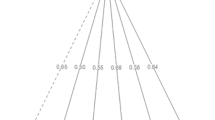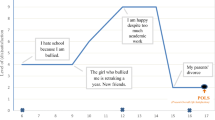Abstract
In spite of the significance of life satisfaction (LS) for adolescent health and well-being, the past decades have yielded limited progress in investigating the psychometric properties of a well-used inventory measuring LS, The satisfaction with Life Scale (SWLS) in adolescents. The present study aimed at investigating the factor structure, gender invariance, and convergent validity of the Norwegian version of the five-item SWLS in adolescents 13–18 years. The study was based on a cross-sectional sample of 1,073 adolescents from rural areas in Mid-Norway, and the data were analysed using confirmatory factor analysis (CFA) and multi-group analyses in AMOS. Results from the CFA supported a single-factor structure with correlated residual variances between items 4 and 5. The results from the multi-group analyses indicated configural and metric invariance of SWLS between genders, as indicated by invariant factor structure and factor loadings. The SWLS also showed high reliability and correlated in expected directions with measures of emotional symptoms and self-esteem, supporting the convergent validity of the instrument. The psychometric properties of the SWLS need to be further evaluated in adolescents; however the present results indicate that the SWLS is a questionnaire appropriate for assessing LS in a population of Norwegian adolescents.
Similar content being viewed by others
References
American Psychiatric Association. (2000). Diagnostic and statistical manual of mental disorders DSM-IV-TR (4th ed.). Washington, DC: American Psychiatric Association.
Atienza, F. L., Balaguer, I., & Garcia-Merita, M. L. (2003). Satisfaction with life scale: Analysis of factorial invariance across sexes. Personality and Individual Differences, 35, 1255–1260.
Bagozzi, R., & Yi, Y. (1988). On the evaluation of structural equation models. Journal of the Academy of Marketing Science, 16, 74–94.
Barnes, L. L. B., Harp, D., & Jung, W. S. (2002). Reliability generalization of scores on the Spielberger State-Trait Anxiety Inventory. Education and Psychological Measurement, 62, 603–618.
Bollen, K. A. (1989). Structural equations with latent variables. New York: Wiley.
Brown, T. A. (2006). Confirmatory factor analysis for applied research. London: The Guildford Press.
Byrne, M. B. (2001). Structural equation modeling with AMOS. Basic concepts, applications, and programming. USA: Taylor & Francis Group.
Byrne, D. G., Davenport, S. C., & Mazanov, J. (2007). Profiles of adolescent stress: The development of the adolescent stress questionnaire (ASQ). Journal of Adolescence, 30, 393–416.
Cheung, G. W., & Rensvold, R. B. (2002). Evaluating goodness-of-fit indexes for testing measurement invariance. Structural Equation Modeling, 9, 233–255.
Clench-Aas, J., Nes, R., Dalgard, O. S., & Aarø, L. E. (2011). Dimensionality and measurement invariance in the satisfaction with life scale in Norway. Quality of Life Research, 20, 1307–1317.
Diamantopolous, A., & Siguaw, J. (2008). Introducing LISREL. London: SAGE Publications.
Diener, E., Emmons, R. A., Larsen, R. J., & Griffin, S. (1985). The satisfaction with life scale. Journal of Personality and Assessment, 49, 71–75.
Diener, E., Oishi, S., & Lucas, R. (2003). Personality, culture, and subjective well-being: emotional and cognitive evaluations of life. Annual Review of Psychology, 54, 403–425.
Dieserud, G., Røysamb, E., Ekeberg, O., & Kraft, P. (2001). Toward an integrative model of suicide attempt: A cognitive psychological approach. Suicide and Life Threatening Behavior, 3, 153–168.
Dimitrov, D. M. (2010). Testing for factorial invariance in the context of construct validation. Measurement and Evaluation in Counseling and Development, 43, 121–149.
Erdogan, B., Bauer, T.N., Truxillo, D.M., & Mansfield, L.R. (2011). Whistle while you work: A review of the life satisfaction literature. Journal of Management. doi:10.1177/0149206311429379.
Gilman, R., & Huebner, S. (2006). Characteristics of adolescents who report very high life satisfaction. Journal of Youth and Adolescence, 35, 311–319.
Glaesmer, H., Grande, G., Braehler, E., & Roth, M. (2011). The German version of the satisfaction with life scale (SWLS). European Journal of Psychological Assessment, 27, 127–132.
Goldbeck, L., Schmitz, T. G., Besier, T., Herschbach, P., & Henrich, G. (2007). Life satisfaction decreases during adolescence. Quality of Life Research, 16, 969–979.
Gouveia, V. V., Milfont, T. T., da Fonseca, P. N., & Coelho, J. A. P. (2009). Life satisfaction in Brazil: Testing the psychometric properties of the satisfaction with life scale (SWLS) in five Brazilian samples. Social Indicators Research, 90, 267–277.
Gray-Little, B., Williams, V. S. L., & Hancock, T. D. (1997). An item response theory analysis of the Rosenberg self-esteem scale. Personality and Social Psychology Bulletin, 23, 443–451.
Hair, J., Black, W., Babin, B., & Anderson, R. (2010). Multivariate data analysis. Upper Saddle River: Prentice Hall.
Hultell, D., & Gustavsson, J. P. (2008). A psychometric evaluation of the satisfaction with life scale in a Swedish nationwide sample of university students. Personality and Individual Differences, 44, 1070–1079.
Millsap, R. E., & Olivera-Aguilar, M. (2012). Investigating measurement invariance using confirmatory factor analysis. In R. H. Hoyle (Ed.), Handbook of structural equation modeling (pp. 380–392). New York: The Guildford Press.
Moksnes, U. K., Byrne, D. G., Mazanov, J., & Espnes, G. A. (2010a). Adolescent stress: Evaluation of the factor structure of the adolescent stress questionnaire. Scandinavian Journal of Psychology, 51, 203–209.
Moksnes, U.K. & Espnes, G.A. (2013). Self-esteem and life satisfaction in adolescents–Gender and age as potential moderators. Quality of Life Research. doi:10.1007/s11136-013-0427-4.
Moksnes, U. K., Moljord, I. E. O., Espnes, G. A., & Byrne, D. G. (2010b). The association between stress and emotional states in adolescents: The role of gender and self-esteem. Personality and Individual Differences, 49, 430–435.
Neto, F. (1993). The satisfaction with life scale: Psychometrics properties in an adolescent sample. Journal of Youth and Adolesence, 22, 125–134.
Oladipo, S. E., & Balogun, S. K. (2012). How suitable is the satisfaction with life scale for use on adolescents in Nigeria. Science Journal of Psychology, 2012, 1–3.
Pavot, W., & Diener, E. (1993). Review of the satisfaction with life scale. Psychological Assessment, 5, 164–172.
Pavot, W., & Diener, E. (2008). The satisfaction with life scale and the emerging construct of life satisfaction. The Journal of Positive Psychology, 3, 137–152.
Piko, B. F., & Hamvai, C. (2010). Parent, school and peer-related correlates of adolescents’ life satisfaction. Children and Youth Services Review, 32, 1479–1482.
Pons, D., Atienza, F. L., Balaguer, I., & Garcia-Merita, M. L. (2000). Satisfaction with life scale: Analysis of factorial invariance for adolescents and elderly persons. Perceptual and Motor Skills, 91, 62–68.
Proctor, C. L., Linley, P. A., & Maltby, J. (2009a). Youth life satisfaction: A review of the literature. Journal of Happiness Studies, 10, 583–630.
Proctor, C. L., Linley, P. A., & Maltby, J. (2009b). Youth life satisfaction measures: A review. The Journal of Positive Psychology, 4, 128–144.
Rosenberg, M. (1965). Society and the adolescent self-image. Princeton: Princeton University Press.
Spielberger, C. D. (1983). Manual for the state-trait anxiety inventory. California: Consulting Psychologist Press.
Swami, V., & Chamorro-Premuzic, T. (2009). Psychometric evaluation of the Malay satisfaction with life scale. Social Indicators Research, 92, 25–33.
Wu, C., & Yao, G. (2006). Analysis of factorial invariance across gender in the Taiwan version of the satisfaction with life scale. Personality and Individual Differences, 40, 1259–1268.
Zung, W. W. K. (1965). A self-rating depression scale. Archives of General Psychiatry, 12, 63–70.
Author information
Authors and Affiliations
Corresponding author
Rights and permissions
About this article
Cite this article
Moksnes, U.K., Løhre, A., Byrne, D.G. et al. Satisfaction with Life Scale in Adolescents: Evaluation of Factor Structure and Gender Invariance in a Norwegian Sample. Soc Indic Res 118, 657–671 (2014). https://doi.org/10.1007/s11205-013-0451-3
Accepted:
Published:
Issue Date:
DOI: https://doi.org/10.1007/s11205-013-0451-3




